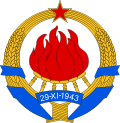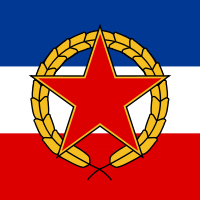- Presidency of Yugoslavia
-
Yugoslavia 
This article is part of the series:
Politics and government of
YugoslaviaExecutiveParliamentElectionsStates
Presidency of the Socialist Federal Republic of Yugoslavia (Serbian: Predsedništvo SFRJ, Председништво СФРЈ; Croatian: Predsjedništvo SFRJ; Slovene: Predsedstvo SFRJ; Macedonian: Председателство на СФРЈ) was a collective head of state of the Yugoslav federation. It was established in 1970 according to constitutional amendments and reorganized in 1974 by the new constitution. In the period from 1970 to 1974, the Presidency had 23 members - three from each republic, two from each autonomous province and president Josip Broz Tito.[1] In 1974 the Presidency was reduced to 9 members - one representative of each Yugoslav republic and autonomous province and, until 1988, chairman of the Presidium of the League of Communists of Yugoslavia ex officio.
Contents
Constitutional powers
According to the 1974 Constitution, the Presidency had following powers:[2]
- representing the federation both inside and outside the country
- commanding the Yugoslav armed forces, deciding on using the army both in war and in peace
- protecting equality of Yugoslav nationalities
- protecting the constitutional order
- proposing a candidate for the federal prime minister
- proposing candidates for federal constitutional judges
- appointing the ambassadors and generals and admirals
- appointing the National Defense Council and, if needed, also other agencies (one of such was Federal Council for Protection of the Constitutional Order)
- giving quarters and awarding state decorations
The Presidency had eight members elected by parliaments of each republic and autonomous province and proclaimed by the Federal Assembly of the SFRY, the ninth member was president of the Presidium of the League of Communists of Yugoslavia. This ex officio membership of the LCY leader was abolished by the constitutional changes in autumn 1988.[3] The mandate of the Presidency lasted five years so the nine-member Presidency was elected in total four times - in 1974, 1979, 1984 and 1989.
Until 1980 most of powers of the Presidency (and control over the country in general) were in fact exercised by Josip Broz Tito, who was president of the republic for life. After his death in May 1980, his office stayed vacant and the Presidency began to function according to the constitution.
Sometimes, the Presidency held its sessions in an extended composition. Besides the members of the actual Presidency, in such sessions took part following officials: chairman of the Federal Assembly, chairman and vice-chairman of the Federal Executive Council (the government), federal secretaries (ministers) of defense, interior and foreign affairs, chairman of the Federal Conference of the Socialist Alliance of Working People of Yugoslavia and chairmen of the Presidencies of the Yugoslav republics and autonomous provinces.[4] The extended Presidency wasn't grounded in the Constitution and couldn't itself adopt any decisions.
Post-Tito period
Tito, as a president of the republic, was ex officio chairman of the Presidency. After his death a new chairman of the Presidency was elected every year. The order of rotating of the members on the leading position was agreed in advance, so this annual election was a pure formality. The rotating system jammed only in May 1991 - Stipe Mesić, representative of Franjo Tuđman's new Croatian government in the Presidency, was about to become the chairman but wasn't elected due to opposition of a half of the Presidency controlled by Serbian leader Slobodan Milošević. The top state office of the disintegrating federation remained vacant until 1 July when Mesić was finally elected.[5] [6]
Only one year after Tito's death, Yugoslav leaders had to face violent riots in Kosovo. On 2 April 1981 the Presidency under chairmanship of Cvijetin Mijatović declared a state of emergency in Priština and Kosovska Mitrovica, which lasted one week.[7] [8] The Presidency declared the state of emergency again, that time on the whole territory of Kosovo, on 27 February 1989 under chairmanship of Raif Dizdarević, when even more serious disorders in Kosovo broke out.[8] [9] For the third time in post-Tito Yugoslavia, the state of emergency in Kosovo was imposed by the Presidency in February 1990.[10]
The composition of the last Presidency elected in May 1989 reflected both approach of political pluralism in some parts of the federation and the beginning agony of Yugoslavia:
- Janez Drnovšek from Slovenia and Bogić Bogićević from Bosnia and Herzegovina were elected in direct elections held in their republics[11] [12]
- representatives of Serbia, Montenegro, Kosovo and Vojvodina, i.e. half of the Presidency, were acting under de facto control of Slobodan Milošević[6] [13]
- Stipe Šuvar, Croat representative of strongly pro-Yugoslav opinions,[14] was in October 1990 replaced by Stipe Mesić nominated by Croatian government.[15]
In summer 1991 Mesić and Drnovšek, regarding their republics independent, ceased to attend sessions of the Presidency. They were followed by Bogićević and Vasil Tupurkovski from Macedonia, so that the Presidency de facto ceased to exist, although the members from Serbia, her provinces (Kosovo and Vojvodina) and Montenegro continued to hold sessions until 1992.[6]
Personal composition (1971-1991)
Presidency 1971-1974 Name Term of chairmanship Representing Josip Broz Tito 1971 - 1974 President of the republic, president of the LCY Vidoje Žarković
Veljko Mićunović
Dobrosav ČulafićSR Montenegro Ilija Rakačić
Replaced by Sreten Kovacević
Maćaš Keleman
Replaced by Mrs. Ida SzaboSAP Vojvodina Ilijaz Kurteši
Veli DevaSAP Kosovo Nikola Minčev
Krste Crvenkovski
Kiro Gligorov
Replaced by Lazar KoliševskiSR Macedonia Hamdija Pozderac
Rato Dugonjić
Augustin PapićSR Bosnia and Herzegovina Sergej Krajgher
Marko Bulc
Mitja RibičićSR Slovenia Dragoslav Marković
Dobrivoje Vidić
Replaced by Koka Popović
Dragi StamenkovićSR Serbia Jakov Blažević
Djuro Kladarin
Mika Tripalo
Replaced by Milan MiskevićSR Croatia Presidency 1974-1979 Josip Broz Tito 15 May 1974 - 15 May 1979 President of the republic, president of the LCY Vidoje Žarković SR Montenegro Stevan Doronjski SAP Vojvodina Fadil Hoxha SAP Kosovo Lazar Koliševski SR Macedonia Cvijetin Mijatović SR Bosnia and Herzegovina Edvard Kardelj1
1979 Sergej KraigherSR Slovenia Petar Stambolić SR Serbia Vladimir Bakarić SR Croatia Presidency 1979-1984 Josip Broz Tito1
1980 Stevan Doronjski
1980 Lazar Mojsov
1981 Dušan Dragosavac
1982 Mitja Ribičič
1983 Dragoslav Marković15 May 1979 - 4 May 1980
President of the republic, president of the LCY
League of Communists of Yugoslavia
Vidoje Žarković SR Montenegro Stevan Doronjski1
1981 Radovan VlajkovićSAP Vojvodina Fadil Hoxha SAP Kosovo Lazar Koliševski 4 May 1980 - 15 May 1980 SR Macedonia Cvijetin Mijatović 15 May 1980 - 15 May 1981 SR Bosnia and Herzegovina Sergej Kraigher 15 May 1981 - 15 May 1982 SR Slovenia Petar Stambolić 15 May 1982 - 15 May 1983 SR Serbia Vladimir Bakarić1
1983 Mika Špiljak
15 May 1983 - 15 May 1984SR Croatia Presidency 1984-1989 Veselin Đuranović 15 May 1984 - 15 May 1985 SR Montenegro Radovan Vlajković 15 May 1985 - 15 May 1986 SAP Vojvodina Sinan Hasani 15 May 1986 - 15 May 1987 SAP Kosovo Lazar Mojsov 15 May 1987 - 15 May 1988 SR Macedonia Branko Mikulić2
1986 Hamdija Pozderac3
1987 Raif Dizdarević
15 May 1988 - 15 May 1989SR Bosnia and Herzegovina Stane Dolanc SR Slovenia Nikola Ljubičić SR Serbia Josip Vrhovec SR Croatia Ali Shukri
1985 Vidoje Žarković
1986 Milanko Renovica
1987 Boško Krunić
1988 Stipe Šuvar
(until November 1988)League of Communists of Yugoslavia Presidency 1989-1991 Nenad Bućin7
1991 Branko KostićSR Montenegro Dragutin Zelenović5
1990 Jugoslav KostićSAP Vojvodina Riza Sapunxhiu6
1991 Sejdo BajramovićSAP Kosovo Vasil Tupurkovski SR Macedonia / Republic of Macedonia Bogić Bogićević SR Bosnia and Herzegovina Janez Drnovšek 15 May 1989 - 15 May 1990 SR Slovenia / Republic of Slovenia Borisav Jović 15 May 1990 - 15 May 1991 SR Serbia Stipe Šuvar4
1990 Stipe Mesić
1 July 1991 - 3 October 1991SR Croatia / Republic of Croatia Notes
- Died while holding the office
- Resigned when he became Chairman of the Federal Executive Council
- Resigned due to accusation of participation on the Agrokomerc scandal
- Recalled by the Croatian Parliament
- Recalled by the Serbian Parliament
- Recalled by the Serbian Parliament
- Recalled by the Montenegrin Parliament
See also
References
- ^ Slobodan Stankovic (1984): Yugoslavia's New State Presidency
- ^ Constitution of the SFRY, 1974 (in Serbian)
- ^ Amendments to the Constitution of the SFRY, 1988 (in Serbian)
- ^ Interview with Raif Dizdarević (in Serbo-Croatian)
- ^ Biography of Stipe Mesić (in Croatian)
- ^ a b c Interview with Vasil Tupurkovski, Radio Free Europe (in Serbo-Croatian)
- ^ Slobodan Stankovic (1982): Kosovo: One year after the riots
- ^ a b Interview with Raif Dizdarević, Radio Free Europe (in Serbo-Croatian)
- ^ Timetable of the conflicts in Kosovo
- ^ Chronology of Yugoslavia's break-up (in Croatian)
- ^ Interview with Bogić Bogićević, Radio Free Europe (in Serbo-Croatian)
- ^ Janez Drnovšek on the English Wikipedia
- ^ Interview with Stipe Mesić, Radio Free Europe (in Serbo-Croatian)
- ^ Stipe Suvar obituary
- ^ Interview with Stipe Šuvar, Radio Free Europe (in Serbo-Croatian)
Categories:- Second Yugoslavia
Wikimedia Foundation. 2010.

